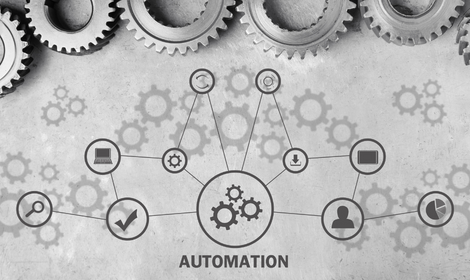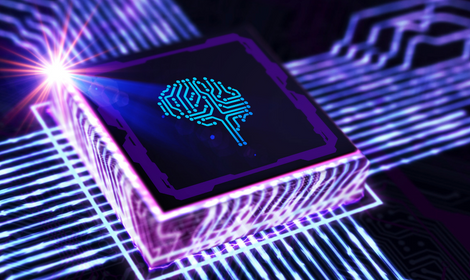Intelligent Process Automation
Intelligent process automation (IPA) takes the robot out of the human. The IPA approach combines fundamental process redesign with robotics and machine learning to create a comprehensive solution. As a result, it can simplify customer interactions and speed up processes radically. Deep and cognitive technologies complement traditional levers of rule-based automation by enhancing decision-making capabilities. It will also help businesses rethink by seamlessly integrating technology, work processes, and people.
Highlights
Human and Machine Coordination
Robotics isn't beneficial unless coupled with an intelligent process automation platform. IPA can coordinate work between robots, people, and systems.Task Automation
Automate labor-intensive tasks through robotic process automation (RPA), which results in a high productivity rate. Facilitate decision-making and manage workflow by consolidating AI and RPA.Risk Analytics
Risk analytics is a collection of techniques that accurately measures, quantifies, and anticipates risk. Managing risks has been a critical responsibility of management for decades. Using risk analytics, companies can develop a baseline to compare risk to many factors for the entire organization. Executives may have the clarity they need to recognize, assess, comprehend, and manage risks by consolidating several scenarios onto a single platform.Secure Administration and Risk Management
Automating end-to-end processes in the business can reduce the risk of errors, such as incorrect data entry. Robotic Process Automation (RPA) handles automatic tasks, whereas if it breaks or varies from organizational standards, intelligent process automation (IPA) ensures consistency.Visualizing Process and Monitoring Customer Journey
In general, each automation technology deployed in the enterprise makes it difficult to see where the results get impacted. With the help of intelligent process automation (IPA), you can identify the bottlenecks and suggest a better solution to the issue.Acceleration Of Operation Transformation
With IPA, you can not only accelerate end-to-end processing but also make changes to processes and the technology that supports them, making them agile. Providing continuous improvements to business processes helps organizations become more competitive.Analytics and Insights
With the new channels and tools, analyzing the data allows you to reach and be accessible to your customers. Examining existing processes and systems for redundancies, conflicts, and leaks through tools such as process discovery will increase operational efficiency.Full Stack Automation
Full stack automation is a potent tool that businesses can immediately boost efficiency and streamline procedures in various areas of their everyday operations. Setting up redundant, digital business processes to be performed automatically, without further human involvement, is known as full stack automation in the business sphere.
Highlights
RPA
The core of robotic process automation is the automation of application-agnostic task-specific procedures. Full stack automation gains repeatable, automated operations using this strategy that may initiate and interact with other processes in simple ways.Optimization across applications
Full stack automation helps organizations expand gradually by integrating new technology into existing procedures. Through full stack automation solutions, a wide range of interconnected platforms and tools may be controlled with relative ease, without their utility being restricted or your organization's business operations being jeopardized.Enhancing outcomes
Incorporating best practices can significantly enhance the outcomes of your organization's daily operations. It can be made simpler by full stack automation, which applies operating rules automatically with no ambiguous deviations.Simplify processes
Organizations can swiftly transfer and automate most of the operations labor required for applications, middleware, hardware, and data center infrastructure thanks to full-stack automation. The process completely covers from development to delivery of applications.Deep visibility
A full stack automation solution provides comprehensive visibility into all aspects of your business's digital operations. In reality, this entails monitoring the availability of third-party solutions, database activity, and other things in addition to applications and servers. Businesses can coordinate optimizations thanks to this level of visibility that may not have otherwise occurred to them or been given top priority.Prioritization
Full stack automation is best suited for repetitive, low-level operations. Even though they are vital, these daily tasks add very little value to your company compared to the time it takes competent workers to perform them manually. Companies can free up staff time and energy for more practical work by prioritizing such jobs for automation.Artificial Intelligence and Cognitive Computing
The future of digital enterprises is being shaped by intelligent systems that can see, listen, understand, and learn. These systems are prepared to provide organizations with real value. Artificial intelligence and cognitive computing promote a distinctive culture of enhanced intelligence, which augments human aptitude and capacities.
Highlights
Adaptive
Making a cognitive system based on machine learning begins with this. The solutions should reflect the brain's capacity for environmental learning and adaptation. It is not possible to program the systems for a single purpose. Data collection, goal comprehension, and requirement understanding must all be dynamic.Interactive
The cognitive solution, like the brain, must communicate with every component of the system: the processor, devices, cloud services, and users. Cognitive systems should communicate in both directions. It should be able to comprehend user input and deliver relevant results using deep learning and natural language processing.Iterative and stateful
Prior interactions in a process should be "remembered" by the system, which should then "return" data appropriate for the current application. It needs to be able to pinpoint the issue by posing queries or locating other sources. It relies on accurate and up-to-date input to ensure the system has enough information and data sources. This feature must apply the data quality and validation techniques carefully.Contextual
Context awareness is essential for thought processes. Contextual information such as syntax, time, place, domain, needs, and a user's profile, tasks, and goals must be understood, recognized, and mined by cognitive systems. The systems may use data from several sources, including visual, audio, and sensor data, and structured and unstructured data.Rapid Transformation
Artificial intelligence (AI) fosters rapid transformation, enabling businesses to incorporate AI across all functional areas and revolutionize values provided to customers. Companies that use AI benefit from data and cutting-edge analytics that speed up processes, improve decision-making, and accurately forecast outcomes for their customers and themselves.Machine Learning
With machine learning (ML), a form of artificial intelligence (AI), software programs can predict outcomes more accurately without having to be explicitly instructed. Businesses can view customer behavioral and operational patterns with machine learning, which also helps with new product development.Digital Process Automation (DPA)
Digital process automation (DPA) automates the transformation of enterprises into data-driven, digital businesses. It facilitates process orchestration across several systems, automates monotonous operations, empowers employees to make data-driven decisions, and offers an adaptable platform for quickly developing user-centered apps.
Highlights
Business processes automation
Every processing stage is outlined and included in the software when you use digital process automation to automate your business processes. You will always have the most up-to-date view of what is happening because any changes are automatically logged.Workflows automation
Our services integrate automation and Artificial Intelligence to predict future states, initiate operations, and support people based on data to serve company goals best and satisfy consumer expectations.Improving Flexibility and Agility
You may increase your flexibility and responsiveness to alterations in market conditions and customer needs by implementing digital process automation. Your company will be less risk-averse, more willing to take chances, and more agile, for instance, by adopting digital process automation to experiment with various goods and solutions.Saving Time and Money
Time and cost savings are the significant advantages that Digital Process Automation offers. Giving your staff the appropriate information at the right juncture will enable them to complete their responsibilities more quickly and efficiently while minimizing manual labor. Organizations can save hundreds, even thousands of working hours by automating many of these repetitive tasks.Integrate Multiple Systems into One
DPA allows firms to automate numerous tasks across company departments into one, helping to increase customer interactions and staff happiness. These interconnected procedures take substantially less time than they would have otherwise, giving businesses more time to concentrate on other initiatives crucial to their growth.IReduction of errors
Another reason businesses consider DPA is that technology can assist them in lowering the potential errors and mistakes while processing the task. Companies can provide more consistent and higher-quality services by doing activities more effectively, which is more likely to attract new clients and maintain existing customer connections.Enterprise AI
Artificial intelligence techniques are harnessed in enterprise AI to drive digital transformation through enterprise software. The use of artificial intelligence in the workplace is fundamentally altering how firms operate. Businesses are integrating AI technologies into their operations to cut costs, increase efficiency, produce insights, and open up new markets.
Highlights
Enhanced productivity and efficiency
Gains in productivity and efficiency are two of the most frequently mentioned advantages of deploying Enterprise AI. It enables businesses to use the skills of their human resources while minimizing the costs involved with doing routine, recurring tasks that can be handled by technology.Data Analytics
Any firm may expand and stand out from the competition with Hansvl's data analytics services and solutions. We find use cases to help you achieve your business priorities, and we develop analytics solutions using the best expertise and tools for your requirements. The future of your data is to be used to boost performance, resiliency, and growth for years to come.Improved business speed
The pace of business in this digital age is already fast, but Enterprise AI will make it even quicker. Additionally, shorter development cycles and a shorter period from conception to commercialization are made possible by Enterprise AI, which results in a higher and more immediate return on investment for development.Improved Customer Service
Indirectly as well as directly, AI can enhance customer service. Customers can immediately access assistance using chatbots and online customer support solutions. They can begin the assistance engagement right away. The AI system can then gather the information required to address their problem or put them in touch with a human representative.Improved Monitoring
During production, embedded AI systems may monitor the efficiency and quality of the machines. These technologies can increase productivity and send out warnings when a piece of equipment needs maintenance. A business can maintain operations on schedule and fix errors that may slow processes with improved monitoring.Better Quality
Enterprise AI can also help with quality assurance. Data and analysis that a person could not obtain through a visual examination of a product can be provided by a computer. This additional examination would enable a business to enhance quality and discover flaws before a product is released to the market.Machine Learning
Machine learning enables businesses to create unique solutions that process large amounts of data and employ complex algorithms to figure out how to complete a task independently. With the help of our machine learning-powered business applications, you can make decisions more quickly, work more efficiently, automate business processes, and spot anomalies more quickly.






